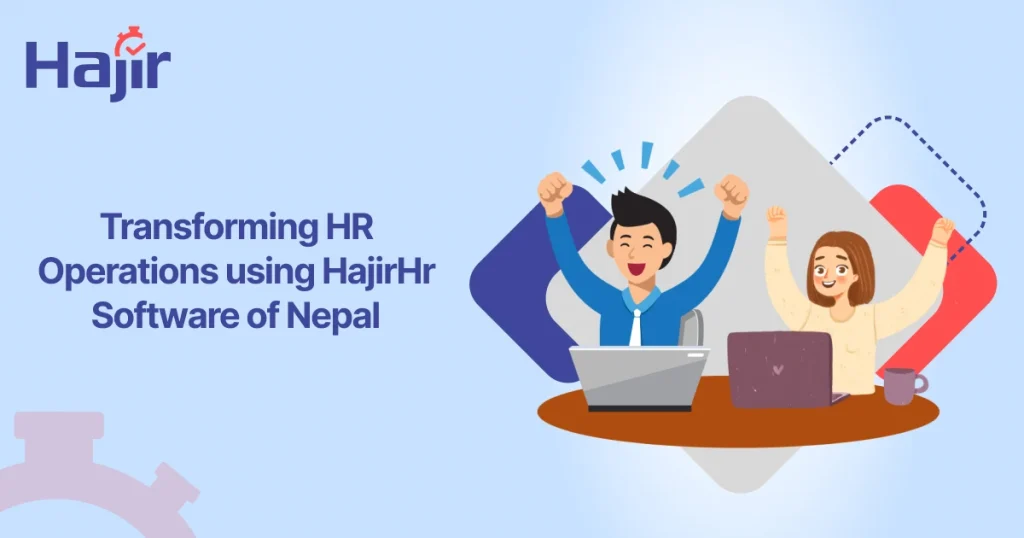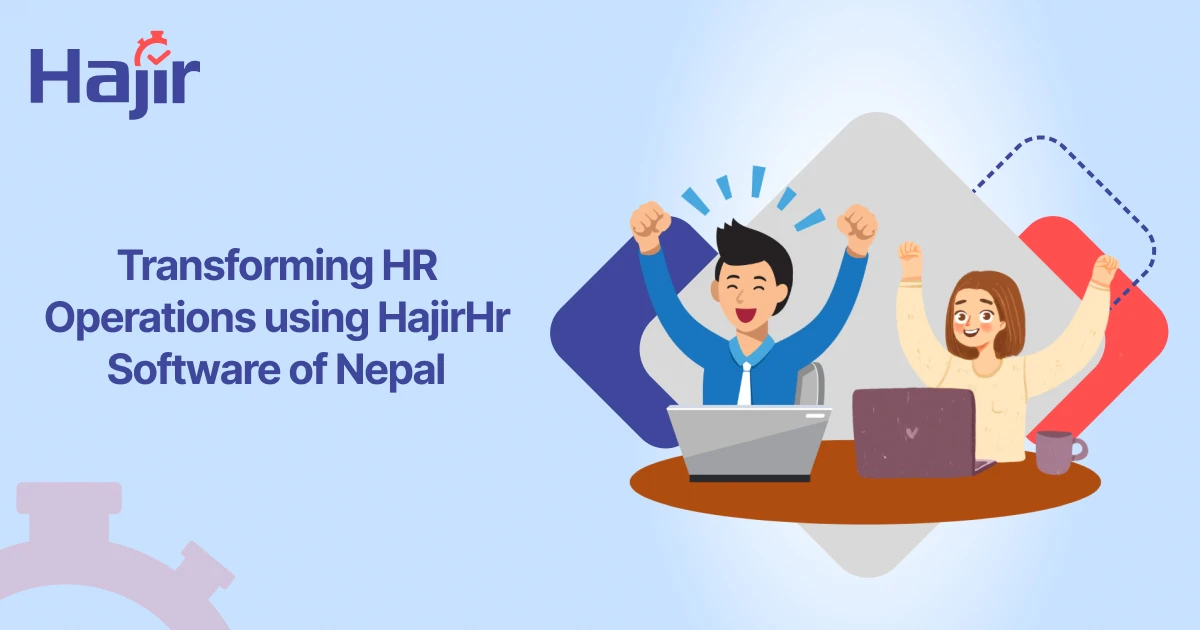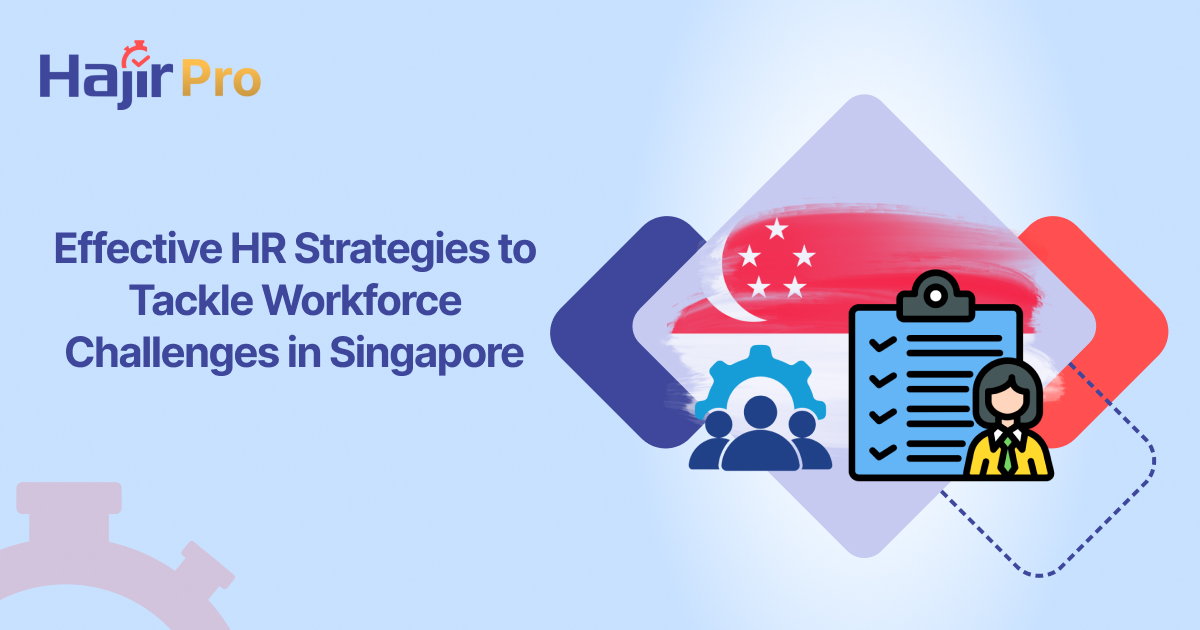HR software of Nepal: Transform HR Operations using HajirHr
The changing business climate in Nepal is placing pressure on the HR departments to ensure that they are efficient, compliant, and provide employees with amazing experiences. This change is facilitated by modern HR solutions like Hajir HRMS that are providing end-to-end services to address attendance, payroll, leave, shifts, assets, and others, and hence the idea of HR software of Nepal is becoming a reality to many organizations.
These systems are the way digital HR tools in Nepal are transforming workforce management, from the ability to track real-time attendance to automated payroll calculations. For companies that are in need of knowing how to automate the HR process in Nepal, the decision to move towards such systems is no longer a choice but a strategy.

HR Software of Nepal and their role in the business
The real meaning of the term HR software of Nepal.
- Designed for Nepali Businesses: HajirHr software is tailored to Nepali local workforce practices and business needs.
- Regulatory Compliance: Assists in local legislation, taxes, SSF, and other compliance needs of the HR.
- Flexible Workforce Management: Processes the various shifts, field personnel, and remote work tracking.
- Employee Lifecycle Management: This is the one that takes care of the onboarding, offboarding, and any employee-related documents.
- Mobile Accessibility: The system is accessible to the employees and HR teams 24/7 through mobile devices as a digital HR tool.
Why Nepali businesses Should have digital HR tools like “Hajirhr”?
- Paper-based HR procedures and manual spreadsheets reduce the speed of operations and cause mistakes.
- Having more than one location or shift employees or mobile employees makes tracking burdensome.
- Accurate records, reporting and audits are necessary in compliance (e.g., tax, labor law).
- Workers demand individual attention, freedom, and honesty.
- HR software ensures that all these challenges are overcome by offering digital HR tools in Nepal under a single platform.
HR automation + HR software = smarter HR
Although the phrase “automation” may imply complete autonomy with artificial intelligence (AI), in the real world, HR software of Nepal (Hajirhr) refers to the automation of monotonous HR functions: attendance tracking, payroll, shift scheduling, leaves, equipment distribution, and reporting. All these are made possible through Hajir HRMS “digital HR tools.”
Therefore, for businesses that may be interested in automating the HR process in Nepal, the trick that may be used is to adopt a system that is developed with these features and fits the local setting.
Key HR Modules That Make Work Easier
1. Attendance & Time-Tracking
Hajir HRMS, “HR software of Nepal,” has several attendance options: WiFi, QR code, selfie, location, and biometric – the functionality of tracking remote or field employees in real-time when they are at the office. This implies that it will reduce the number of manual entries and mistakes and expedite HR visibility.
2. Holiday, Shift and Leave Management
The workforce time arrangement is facilitated by custom leave management (global/custom), multi-level approvals, shift management (flexible/fixed/multi-shift), and duty arrangements.
3. Calculation and Compliance of Payroll
HR software of Nepal “Hajirhr” automates live payroll calculation based on attendance, overtime, bonuses, loans/advances, tax (SSF, CIT/TDS), and insurance. To Nepali organizations this implies greater accuracy and reduced administrative overhead.
4. Asset, Task and Communication Management
In addition to conventional HR, such functions as asset lifecycle, project/task management, chat inside the organization, events and announcements enhance the establishment of a single HR-ecosystem.
5.Reporting & Analytics
Excel/PDF-based 33+ dynamic reports on payroll, attendance, leave, and audits, – allowing the HR to make evidence-based decisions instead of using guesswork.
How Nepali Businesses Can Make the Shift
Step-by-Step Approach to Adoption
- Evaluate the current manual processes and locate controls (e.g., attendance errors, payroll lateness).
- Select an HR platform designed to support Nepal (such as Hajir HRMS) with local compliance, mobile/field workers, and multimodules.
- Plan onboarding: information about employees, organization structure, attendance and leave policies, and shift hours.
- Train human resources and staff on self-service applications (attendance applications, leave requests, and pay slip applications).
- Monitor and improve: utilize analytics and reports to recognize the problems (late clock-ins, high overtime, leave carry-forward) and modify them.
Overcoming Common Challenges
- Digital literacy: Provide training and simple user interfaces.
- Resistance to change: Disseminate benefits (saving of time, transparency, mobile access).
- Data migration: Clean up data in an old system prior to migration to a new system.
- Infrastructure: Stable internet, mobile, or even offline should be guaranteed.
The Role of “AI in HR”
As HR software of Nepal, “Hajirhr” automates the tasks; the next step is to bring AI, e.g., detecting the potential risk of turnover, recommending the optimal shift scheduling, and training demands. The next generation of platforms should be considered by businesses that are making preparations in operation towards the future.
Conclusion
Investing in HajirHr, HR software of Nepal is a crucial move to modernise the HR operations of Nepali businesses intending to do so. Such tools as Hajir HRMS show that integrating digital HR tools Nepal with the automation of manual processes can lead to the significant decrease of the working load, increase of the accuracy and satisfaction of the employee.
In a nation where workforce trends are heterogeneous (office, field, and remote) and regulatory complexity is to be expected, understanding how to computerize the HR process in Nepal is what divides reactive HR and strategic HR. The secret lies in implementing an end-to-end HR system that can meet the local demands and be scalable in the future (including possible AI in HR).
FAQ
What is HR software of Nepal?
HR software of Nepal is a software that allows managing attendance, payroll, leaves, assets and others in Nepali businesses according to the local regulations.
What is the difference between digital and traditional HR?
Digital HR eliminates paper and spreadsheets in favor of mobile/web access, current updates, automatic calculations, and visible dashboards.
Are small businesses able to use HR software as well?
Yes, the present-day HR software can be scaled and is applicable to both small and big-time businesses.
What does “AI in HR” mean?
AI may assist in predictions (such as employee turnover), intelligent scheduling, automation of recruitment, and HR data analysis.
What is the way to begin automation in HR in Nepal?
Test the existing HR system, select Nepal-based software, educate your staff and begin with the basic functions such as attendance and payroll.



